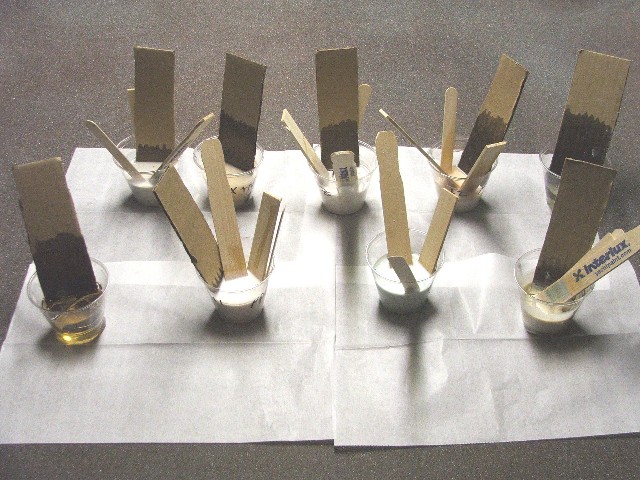 Penetrating Epoxy
Resin
Penetrating Epoxy
ResinPROGRESSIVE EPOXY POLYMERS, INC.
Nothing but Quality Products at Good Prices, Great Customer Service, and Lots and Lots of Helpful Information
and NO SALES TAX - You are shopping in TAX FREE New Hampshire
ABSOLUTE BEST SOURCE for epoxy information, options, USA made products, 24/7/365 help, and support
(EMAIL 603 435 7199)
|
WHO ARE WE? Watch our short 2-minute Progressive Epoxy Polymers video |
We are the only technology based coating/epoxy/resin company that actively encourages your phone calls, not just during our East Coast work hours but also after/before hours, evening, weekends and even holidays. We're available when you are. We form a personal relationship with our customers and freely share technical information, how to-advice, product information and tips-and-tricks. Speak with a non-salesman technical professional with over 25 years of experience in the resin/coating/epoxy industry (no newbie staffer on the phone lines!). Floors, tables, boats, leaks, rot repair. We handle it all! We are an 'always available,' one-on-one, technical/scientific, coating company (watch our video). We are NOT one of those fluffy/slick mass sales firms the dominate the internet selling cheap third party (made in China???), low end epoxies and coatings with no real knowledge of what they are selling and quotas to sell to as many people as possible. 603-435-7199 (east coast time).
PRIMARY STORE LINK --- TOP SELLING PRODUCTS --- EPOXY GURU HELP SITE --- EPOXY DATA SHEETS
EPOXY RESIN SYSTEMS
 Penetrating Epoxy
Resin
Penetrating Epoxy
Resin
WHAT THIS SITE COVERS:
Penetrating epoxy basics
Don't be fooled by amazing claims. Penetrating epoxies are much less than they claim to be
The term 'penetrating' epoxy is rather vague. Usually it means an epoxy resin with a lot of solvent added. the solvent(s) soak or penetrate into the wood or whatever taking with it some of the epoxy. The amount of penetration really varies. If solvent or water will not soak very far into your surface, the solvent thinned epoxy will not either. Penetration is also bad with damp or wet surface. There is little physical reason for the epoxy/solvent to be 'drawn into' an area loaded with water. Penetrating epoxies are very watery and usually contain more solvent than epoxy.
|
Marine 1 Page Product/Price list --- for Marine Catalog |
|
DIY 1 Page Product/Price list --- for DIY/Commercial Catalog |
|
Help EMAIL US // Boat Links // Floor Links // DIY Repair Links // BUY online // SITE MAP INDEX |
Penetrating Epoxy Resin - Facts -
Test Results
Don't be fooled by amazing claims. Penetrating epoxies are much less than they
claim to be
Your Host and Tour Guide:
Paul Oman, MS, MBA - Progressive Epoxy Polymers, Inc. (floor epoxies, marine epoxies, underwater epoxies, repair epoxies)
Member: NACE (National Assoc. of Corrosion Engineers), SSPC (Soc. of Protective Coatings)
"Professionals helping Professionals"
|
If your "HELP" person can't explain nonyl-phenol, cyclo-aliphatic epoxies, epoxy adducts, MCU urethanes or LPU polyurethanes, they're salespeople and not coating professionals. If your "SUPPORT" person won't return your call on a Sunday afternoon, they're not really interested in you. At Progressive Epoxy Polymers/EpoxyProducts.com we are your Help and Support Professionals. Call : 603 - 435 7199 |
|
We spend $475 (2017) each year with the regional Better Business Bureau supporting our community, our fellow businesses and living up to their high demands of honesty and performance. We believe in old fashion values of personal and business integrity We also maintain professional memberships in national coating and scientific associations reflecting our background in the technical and chemical aspects of epoxy resin systems for over 25 years. We hope you include this information in our consideration when deciding to do business with us and when evaluating Progressive Epoxy Polymers against other online vendors. |
PROGRESSIVE EPOXY POLYMERS, INC.
|
PAGE AND SITE NAVIGATION |
|||||||||||||||||||
MEMBER: Internet Epoxy Confederation (IEC - CLICK HERE TO VISIT) -- "Where Professionalism Still Matters"
We've been selling epoxy - marine epoxy (boat building - wood / fiberglass repair) industrial coatings - garage paint - underwater epoxies - thick putties - tabletop resins and supplies since the early 1990's
.................................................... The EPOXY GURU - Internet's most popular epoxy repair/help site. Leave your questions for the everyone's favorite Guru. 7 epoxies/coatings to fix 'darn near' everything - today's best coating technologies See how Sunken Yacht is saved by epoxies applied underwater
|
|
Before you buy anything from anyone, we HIGHLY SUGGEST you CALL OR EMAIL US (24/7/365). Let's make sure you have the right products for the job, an understanding of how to use them and a feel for what might go wrong. And if you purchase our products feel free to CALL OR EMAIL US again (24/7/365) before you use them for "tips and tricks" or just some "hand-holding." Perhaps when you're done you'll let us put up some of our pictures on our web site. |
|
EXPLORE THIS SITE WITH CONFIDENCE. Unlike most of our competitors we do not track your mouse clicks. You will not be hounded for the rest of your life by unwanted online ads after visiting this site. |
EPOXY GURU - "how to" epoxy/coating help.
Professionals serving Professionals (and informed consumers) - Member: NACE (National Assoc. of Corrosion Engineers) - SSPC (Soc. of Protective Coatings) - BETTER BUSINESS BUREAU (buy with trust)

| "Hi there! This e-mail has no question but I was just looking through your site and I wanted to say that it's great! I was just looking around the internet to read about the subject of epoxy and no other site I visited was as helpful as yours. You are very knowledgeable in that subject and I admire that. Great work and I wish you the best! " - Gabriella 10/15 |
|
You don't find endorsements like this on other sites! |
BASICS:
The term 'penetrating' epoxy is rather vague. Usually it means an epoxy resin with a lot of solvent added. the
solvent(s) soak or penetrate into the wood or whatever taking with it some of the epoxy. The amount of penetration
really varies. If solvent or water will not soak very far into your surface, the solvent thinned epoxy will not
either. Penetration is also bad with damp or wet surface. There is little physical reason for the epoxy/solvent
to be 'drawn into' an area loaded with water. Penetrating epoxies are very watery and usually contain more solvent
than epoxy.
Epoxy 'primers' are solvent thinned epoxy often used to seal or stabilize the surface of wood/fiberglass etc. prior
to coating that surface with some sort of paint or coating, including more epoxy. The big difference between primers
and penetrating epoxies (in a very general sense) is the amount of solvent. Primers are usually 10-25% solvent
while penetrating epoxies are/were 50-75% solvent.
Solvents are cheaper than epoxy so these products should, in theory, be cheaper than regular solvent free epoxies.
This is usually not the case. You can make your own primer or penetrating epoxy by adding solvent to just about
any epoxy. Although it is logical to begin with a thin watery epoxy and then add solvent (like our Low V epoxy),
I would simply use a thicker marine epoxy if that is what I had available.
How much solvent is in your epoxy? Most regular epoxies contain no solvents. Penetrating epoxies will list how
much solvent they contain in several ways. Consider 10 ounces of a penetrating epoxy. The amount of solvent it
contains can be identified in several ways. All the following convey about the same information: 30% solids, 70%
VOC, 700 G/L (grams per liter), 6 lbs/gal VOC. This product is approximately 3 ounces of epoxy and 7 ounces of
solvents.
A little bit about rot. Wood rot is often a result of dampness and often that dampness is not completely dried
away when repairs are made. Best approach is to scrap out as much of the rotten wood as possible, kill the remaining
rot fungus by soaking area with anti-freeze. Let dry (weeks) then seal with solvent thinned epoxy (primer or penetrating,
probably doesn't matter) then fill hole with a piece of wood and or exterior putty (epoxy putty tends to be too
hard to sand easily), then paint. More on rot - CLICK HERE.
Warming the epoxy will decrease its viscosity and improve penetration. So too will warming the surface it is being
applied to. As the object cools, the air in it will contract, helping to draw the epoxy into the object.
As a 'sealer',' 'primer', or 'undercoat' for paints or varnishes, epoxies have proven their worth. No special product
is needed here. In my opinion, just about any epoxy, thinned or unthinned, will perform this task in a satisfactory
manner.
Because of the lack of true penetration into anything other than very dry end-grain wood, and because of new air
quality (VOC) laws and regulations, the terms, "penetrating" and "primer" are rare used by
the manufactures of these days. Now, they are more commonly described as "bond enhancers" and/or "sealers".
We admit it, our competitors don't!

Don't be fooled by "out of this world"
performance claims...
|
Epoxy Only Web Google Search |
|
 |
#1) Google Everything Epoxy Searches #2) Google Marine Epoxies Searches
#3)Google
Floor Epoxy Searches |
|
View our Progressive Epoxy Products, Inc. |
------------------------------------------------
My Observations:
1) Even a small amount of solvent noticeably increased epoxy penetration.
2) The solvents and solvent mixes generally performed about the same for me in my tests. Xylene seemed work well (best) and is easily obtainable at a local hardware store. It quickly become the solvent used I used in most of my tests. I paid about $15 for a gallon of xylene in a local hardware store.
3) Epoxies with a lower initial viscosity before thinning, penetrated better (and were thinner) when solvents were added to them (common sense).
4) Even a small amount of solvent greatly affected the epoxy gel/set time. With only 10% -15% solvent the time it took for the epoxy to set (in a 0.5-1.0 inch thick layer inside an open wide-mouthed, pint container) increased from several hours (no solvent) to 1-2 days. With more solvent, gel time could be up to 4 days.
5) The additional of solvent made the resulting block of epoxy very rubbery. At 10% this rubbery affect was minimal and slowly went away. At 15% there remained a bit of give to the epoxy blocks. At 33% the epoxy became a rubbery block. At 50% or better, the result was ‘Jello'. The ‘Jello' took several days to form.
6) Some epoxies are more affected/damaged by the addition of solvent to thin them. Adding solvents to epoxies will change the pot life of the epoxy. With most epoxies this change is dramatic. But with cycloaliphatic epoxies, which use ring shaped molecules, the affect is less dramatic. Pot life is not extended nearly as much as with 'regular' epoxies. Our ESP 155 epoxy sealer and primer is a high end cyclo - epoxy with about 24% solvent. Adding more solvent doesn't change the working time (pot life) very much. Bottom line: using something like our ESP 155 might be a better option than adding solvent to other epoxies (like our LOW V or Basic No Blush) if you want to keep working time (pot life) from being excessively long (and the epoxy perhaps more 'damaged' by the solvent). That said, most folks are fine with solvent thinning ANY epoxy - especially in warm weather which will greatly shorten pot life.
Also, our product (ESP 155) uses a very high end cycloaliphatic epoxy - instead of the very low end epoxies found in other solvent thinned epoxies of this kind. The brand above uses so little epoxy it doesn't even offer epoxy info in its msds sheet.
|
Why ESP 155 epoxy sealer and primer is the BEST in its class: 1) Uses superior CYCLOALIPHATIC curing agents and epoxy ADDUCT formulation 2) solvent based for better penetration 3) moisture tolerant, very low viscosity 4) strong user support / feedback 4) 24/7 support |
| THIS PRODUCT | xx | EMAIL US | xx | |
| air shippable | cycloaliphatic system | xx | ||
| no nonyl phenol | epoxy adduct system | xx | ||
| multi curing agents | bulk pricing | |||
| solvent free | no Calif. sales | xx | ||
| 2 part epoxy | xx | 2 part poly | ||
| apply underwater | bubble breakers | |||
| favorite(s) product list | xx | data sheets | xx | |
| PACKING - jugs/bottles | PACKING - cans | xx | ||
| find in non marine cat | xx | find in marine catalog | xx | |
| PRICES/ind/commercial | xx | PRICES/marine section | xx | |
| BUY online | BUY online | xx | ||
| home page | xx | contact page | xx |
Let's talk (603 - 435 - 7199 or EMAIL)
Our Competitors are not happy with us and their lawyers respond!
Learn more Click Here.
|
|
WOW! 35% - 40% of all daily online or telephone orders are from existing customers. That's an amazing 'REPEAT CUSTOMER" number. |
|
603 - 435 - 7199 ANYTIME 24/7 FOR HELP OR ORDERS |
|
|
|
|
HOW I PERFORMED MY TESTS
I generally mixed up 6 oz test samples in plastic cups. I measured penetration by inserting a cardboard strip into
the test sample and seeing how far up the strip the test solution traveled. The test solution turned the cardboard
from light tan to dark brown. This dark color remained long after any solvent might have evaporated away turning
the cardboard back to its original color (this was never observed). I had similar results using wooden paint stirring
sticks in the solutions, although the affects were more pronounced and easier to observer using the cardboard.

We really appreciate you visiting PROGRESSIVE EPOXY POLYMERS, INC. and our web site: EPOXYPRODUCTS.COM. Take advantage of the CONTACT links on this page to ask questions about our products and/or your projects. You can stay in touch with us via our NEWSLETTER (link on our contact page) which is emailed every 6-8 weeks.
This current page is all about:
REMARKS/OBSERVATIONS
I have always questioned why ABCD has so much solvent and so little epoxy. Thinning epoxy 10-25% with solvent seems
much more reasonable. However, I observed that penetration is greatly increased when the solvent % (by volume)
exceeds that percent of epoxy. In other words, more solvent than epoxy. This was something new to me. I still believe
that from priming surfaces the 10-25% dilution is right, but is maximum penetration is the goal, the first coat
should have excess solvent.
For my initial tests I used our ESP 155 epoxy primer, which is already approx. 24% solvent. I then added equal
amounts of solvent to the ESP so total % of solvents in my test cases were about 74% (vs. about 69% for ABCD).
This product is a Progressive Epoxy
Polymers, Inc. best selling, favorite product. Visit our FAVORITES - 7
EPOXIES THAT WILL FIX ANYTHING web page
at:
epoxyproducts.com/favorites4u.html View other popular one-of-a-kind
products.
For the last year or so I had suspected the naphtha to be perhaps the ‘secret ingredient' in ABCD (if it did have
a secret performance ingredient). When I tested with naphtha as the sole solvent I found it didn't mix will with
the epoxy. Much of it separating out from the epoxy. I solved the separating problem by using a 50-50 mix of naphtha
and xylene. However, I also observed that using all xylene gave better and quicker penetration. To my surprise
the penetration observed with ABCD was clearly ‘middle of the pack' or less.
Isopropyl alcohol is one solvent that can be mixed with water. This suggested that it might be a better solvent
in or on damp surfaces. I repeated my tests using damp cardboard and 1 container with alcohol as the sole solvent,
one with just xylene and one with a 50-50 mix of xylene and alcohol. I also poured a bit of water on to top of
each test cup. Somewhat surprisingly, the xylene only mixture still produced the best penetration. It also managed
to incorporate the water I added to the mixture. No free standing water was observed in the cup after the epoxy
had gelled. There was free water in the alcohol only test cup.
AFFECTS OF LARGE AMOUNTS OF SOLVENTS IN EPOXIES
When a solvent thinned epoxy is spread out as a thin layer or passed through a spray gun, I suspect that most of
the solvent is evaporated away before the epoxy sets up. When epoxy and solvent are mixed and allowed to sit in
a cup, there is very little evaporation. The epoxy slowly (very slowly) begins to harden into something like Jell-O
(tm). Over time it will get a bit harder (like a hard boiled egg) but I have never seen it get rock hard (even
with samples months old). The warning here is don't add solvents to epoxies that you want for strength. Solvents
will weaken the epoxy but also give it flex.
SET TIMES
As stated above, an epoxy mixture with 65 to 75% solvent takes a long time to set or gel. In my tests above it
typically took about 40 hours to gel in the cups. The exception was the ABCD. It took about 80 or 90 hours to gel.
Is this a unique attribute of ABCD? I can think of no benefit from a 90 hour pot life vs a 40 hour pot life. Still,
perhaps it is somehow improving real world performance.
I set out to try to match the long ABCD pot life. I did this by using as my base epoxy, our Summer Bond epoxy -
a solvent free marine epoxy designed for hot weather. In other words, it cures slower than other epoxies so it
has a longer pot life in warm weather (actually a longer pot life under all conditions). Because this epoxy starts
out with no solvent in it, I added 2 parts solvent to 1 part epoxy. This gave me a final solvent percentage of
66%. It also gave me the 80-90 hour pot life seen with ABCD
CONCLUSIONS
Maximum penetration in penetrating epoxies comes when the solvents comprise 65-75% of the mixture. Common xylene
appears to be the best solvent to use. While any epoxy could be thinned and used, we recommend our ESP 155 epoxy
(which already contains some solvents, is a 1 to 1 mix and is sold in ½ gal units) mixed with equal amounts
of xylene - an easy to do mixture. If one wants the exceptionally long pot life (which doesn't seem to be much
of an issue, maybe) similar to ABCD use our warm weather Summer Bond epoxy which is a 3:1 mix and sold in 1 gal
units. To every unit of mixed Summer bond epoxy add 2 units of xylene. - Note: summer bond is no longer available
(1/2007)
By making your own solvent thinned penetrating epoxy you can save ½ to 2/3 of the cost of purchasing ABCD.
Warming the epoxy resin will decrease its viscosity and improve penetration. So too will warming the surface it is being
applied to. As the object cools, the air in it will contract, helping to draw the epoxy into the object.
As a 'sealer',' 'primer', or 'under coat for paints or varnishes, epoxies have
proven their worth. No special product is needed here. In my opinion, just about any epoxy, thinned or unthinned,
will perform this task in a satisfactory manner.
------------------------------------------------
A Warning: In researching this topic I talked with other full
time epoxy professionals both inside and outside the marine industry. I was graphically reminded of the health
hazards and flammable nature of solvents. Use EXTREME care when working with them in engine areas, confined spaces,
and in open flame heated work areas.
LEGAL NOTICE: There are federal, state and sometimes county restrictions for the use of solvents. High solvent
products are generally illegal throughout the entire USA. The 'fix' by these vendors is to use some 'low end (???)'
solvents that are exempt from the regulations. So, instead of a good product, you might just be getting a 'legal'
product. For details on VOC (solvent) restrictions see: https://epoxyproducts.com/voc.html.
Note that if you add solvents to products and thus exceed the VOC regulations in your area, you are technically
breaking the law.
In this new round of testing I used softly packed sand for the 'testing'
medium as it had uniform porosity that was repeatable sample after sample.
Four different test epoxies were used, a uniform amount of each poured upon the sand surface. After the epoxy had set, I measured the weight of each 'sand lump' as an indicator or penetration.
Sample 1 - commercial penetrating epoxy with solvent level of approximately 70% - (two tests) sand mass 75-80 grams
Sample 2 - ESP 155 penetrating epoxy (solvent level 25%) - sand mass 60-65 grams
Sample 3 -ESP 155 with additional solvent (approx. 70% solvent) - sand mass 70-75 grams
Sample 4 - Low V (low viscosity) solvent free epoxy - sand mass 50 grams
NOTES: the large sand masses of samples 1 and 3 (low epoxy %) easily broke apart. The higher epoxy % masses did
not break apart easily.
CONCLUSIONS: more solvent equals more penetration, but less strength.
LOW V™ (thin, solvent free
epoxy - add solvent to this to make a penetrating or priming epoxy) - Click Here
ESP 155™ (our own clear primer epoxy with approx. 25% solvent - add more solvent for an easy penetrating epoxy) - Click Here
from our large Primary web store
Order
any of these
Products
NOW
OTHER LINKS:
What can go wrong with epoxy floors - www.epoxyproducts.com/problem.html
Treating pinholes (air bubbles) in epoxy coatings - www.epoxyproducts.com/pinhole4u.html
Treating rot - www.epoxyproducts.com/rot.html
Competitor's penetrating epoxy solvent list - www.epoxyproducts.com/solvents.html
Sealing wood (tests) - www.epoxyproducts.com/woodseal.html
Zinc Primers - www.epoxyproducts.com/zinc.html
Using copper powder in epoxies - www.epoxyproducts.com/copper4u.html
ON-LINE CATALOG HOMEPAGE.
Inside Our non-marine, commercial, DIY Catalog:
corro coat FC 2100; water gard 300; CM 15; crack coat™; liqua tile 1172 potable water; water prime
Find Corro Coat FC 2100 and Water Gard 300 epoxy in our Best Selling - fix anything Catalog
water bond (water based); industrial floor epoxy; bio vee seal; walnut shell; rough coat grit filled epoxy floor paint; epoxy clear top resi
wet/dry 700; splash zone A-788, epoxy cream; splash zone a-788
Find Wet Dry 700 epoxy in our Best Selling - fix anything Catalog
low V epoxy; basic no blush; ESP 155; Bio-Clear 810; epoxy clear top resin
Find Low V, Basic No Blush, and ES 155 epoxy in our Best Selling - fix anything Catalog
Aluthane moisture cured urethane; Acrylic Poly UV Plus and other 2 part polys ; Capt. Tolley's creeping crack sealer; india spar varnish;
Find Aluthane in our Best Selling - fix anything Catalog
fumed silica; fiber fill; micro balloons/micro-spheres; graphite; wood flour; EZ thick, rock flour;
water activated pipe wrap; TA 661 solvent-free epoxy brush cleaner; fiberglass tape/cloth
short nap epoxy rollers; epoxy/stone deck resurfacing roller; 1 inch foam brushes; 2 inch bristle brushes; tongue depressors
Questions? / Phone order? / EMAIL / CALL 603-435-7199 EST / BUY ONLINE
GOOGLE SITE SEARCH - Click here Epoxy specific site search
Click here - YouTube video. Learn about Progressive Epoxy Polymers Inc.
EVAL4U - how to evaluate your epoxy vendor - CLICK HERE -
|
PRODUCT SPOTLIGHT: |
|
|
Wet Dry 700 Epoxy Ultimate Repair Epoxy Paste Above and below the Waterline Like Nothing You Have Ever Worked With Before! Need to fix, glue, patch, fill, bond, coat or cover something underwater? Need to reinforce/wrap corroded, damaged or leaking pipes (with epoxy and fiberglass cloth)? Need to do a fiberglass cloth and epoxy repair with a non sagging epoxy paste? (even underwater?). How about sealing electrical connections in a ‘glob’ of waterproof epoxy? Patching some wood rot? One of our customers repaired serious rot in an 100 year old marine railway submerged under 12 feet of water. Wet Dry 700 has saved sinking boats (and sunk boats - read Escape From Hermit Island available at Amazon.com. The authors recommend you don’t leave your dock without this epoxy - see epoxyproducts.com/cs_boat.html). It is also used on leaking pools and corroding barge mounted floating homes. Welcome to the world of Wet Dry 700 (tm) Epoxy Wet Dry 700 (tm) epoxy paste is a leading example of consumer driven epoxy technology, resulting in a versatile, field friendly repair product for difficult environments. Wet Dry is a solvent free, high performance epoxy reinforced with kevlar (tm) pulp and feldspar/ceramic. It can be applied to wet, damp, or dry surfaces. Wet Dry 700 looks a bit like joint compound (dry wall mud), or cake icing with a simple 1 to 1 mix ratio that you can ‘eyeball’. A scoop of Part A and an equal scoop of Part B and you are ready to go. This is one of our top selling epoxies. People first buy it for a specific project and then generally buy more just to have on hand. |
|
|
"I cannot believe how incredible this Wet Dry 700 is. It's revolutionary. The original repair to my storm shelter would have lasted years if the shelter would just shifting around in the ground. DON'T STOP SELLING THIS STUFF!" Jeff 1/2013
( 10/2013) Comments: Returning - Underwater repair |
|
|
Another Amazing Product - ALUTHANE aluminum Moisture Cured Urethane Coating - corrosion fighting, heat reflecting, temperature resistant sealer, primer, top coat. Use on wood, metal, fiberglass, cement. READ MORE |
|
|
PROGRESSIVE EPOXY POLYMERS, INC - 603 - 435 - 7199 Amazing Products - Amazing Support |
|
|
data sheets and msds and SDS sheets at epoxyproducts.com/datamsds.html |
Epoxy Only Web Google Search
#1) Google
Everything Epoxy Searches
#2) Google
Marine Epoxies Searches
#3)Google
Floor Epoxy Searches View
our Progressive Epoxy Products, Inc.

 |
Boat Repair - Marine Epoxy Massive Link Site <==== click |
Epoxy Floors - Options & Products Massive Link Site click ====>
|
 |
|
Epoxy 101 Epoxy Education Link Site click ====> |
|
|
Home Repairs With Epoxy Massive Epoxy Fix Link Site <==== click |
 |
Arron's Directory of Epoxy Web Sites (part 1) <==== click |
Arron's Directory of Epoxy Web Sites (part 2) click ====> |
|
|
Epoxy Home Page click ====> |
 |
 |
Epoxy Index Page Find Info By Subject <==== click |
|
|
Photo Gallery Neat Boat Pictures <==== click |
Copulas of the Suncook River Valley - Central NH click ====> |
|
|
Epoxy Questions? Ask Prof. E. Poxy click ====> |
|
 |
Contact Us or Order Epoxies <==== click |
 |
DIY Poured Epoxy Bar Tops <==== click |
Outdoor Epoxy Pebble Deck Re-Coat / Repair click ====> |
 |
 |
 |
 |
||
|
site master |
protagonist |
ground zero |
|
HELP IMPROVE THIS PAGE Your comments, suggestions, contributions and insights about this web page are appreciated. Any pictures, product or page feedback and suggestions to help future product users or page readers is win-win for everyone. Please click on the email address below to send us your remarks, and thank you for your response. |
|
email us at: IMPROVE THIS PAGE |
| Help Page - Catalog Page Links |